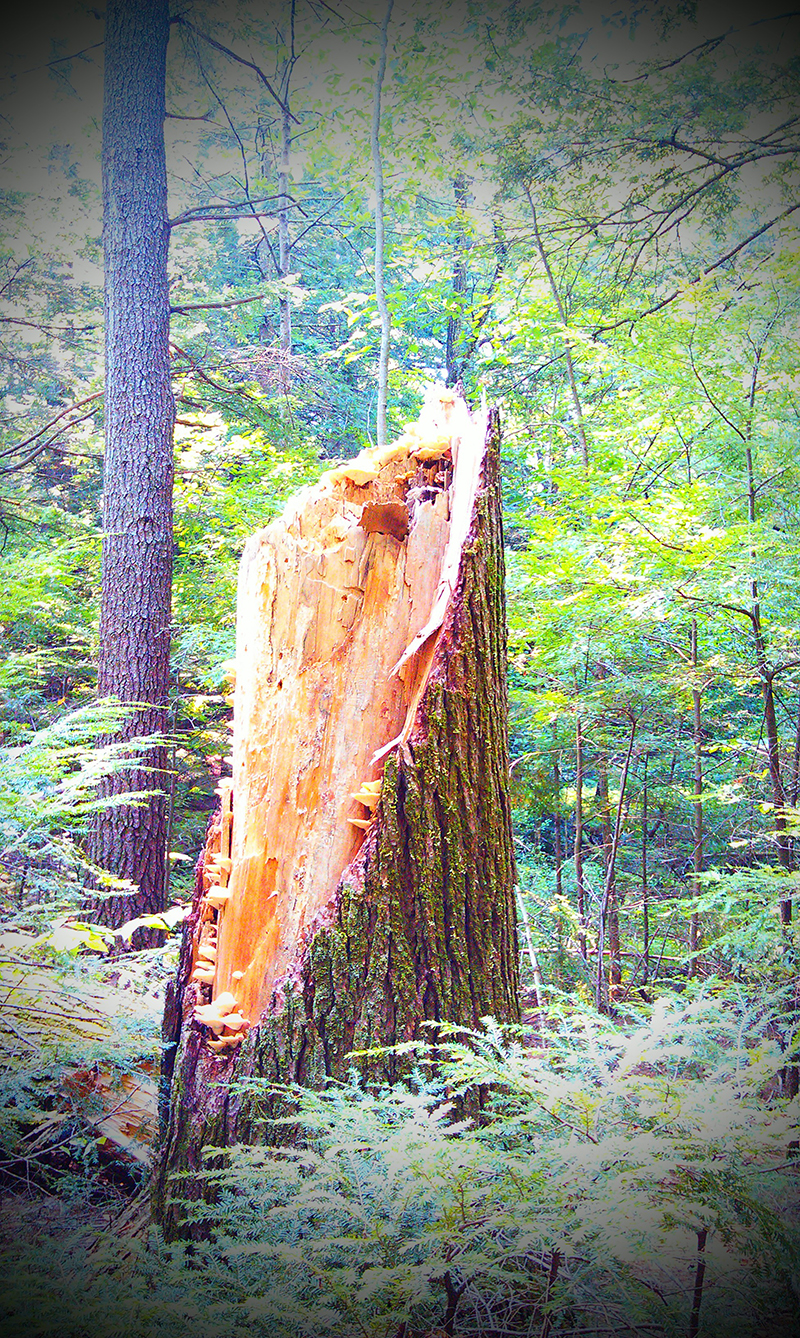Persistence and Decay

During the heaviest snowfalls, even the strongest trees are vulnerable. The weight of wet, sticky snow bears down on large branches and, with the help of gusty winds, causes the structure to collapse. Walking along the forest paths in the spring, we see newly fallen branches and trunks alongside those that have come before. Older fallen limbs are less striking, but reveal the underlying message of a sustainable ecology: that which has served its useful life gives itself up in service of new life. A fallen branch is a buffet of decay as animals, insects, fungi, and moss pick and choose from the offerings. But what if these giants refused to submit themselves to the ecosystems that surround them, stubborn and stingy as the creatures that Dorothy, Tin Man, and Scarecrow encounter in the forest of Fighting Trees?
As media and policy critics note, corporate giants of the film, record, and tech industries have likewise held the fruits of artistic labor close to their chests, under the protective shield of ever-more-restrictive copyright and intellectual property laws. It is an issue highlighted in a meme that spread through social media last New Year’s day under the title, “What Could Have entered the public domain on January 1, 2014?” The answer: Jack Kerouac’s On the Road, Dr. Seuss’s The Cat in the Hat, and – perhaps most ironically, given her role in inspiring the very policies that exacerbate corporate overreach – Ayn Rand’s Atlas Shrugged. Had copyright terms not been extended through industry pressure and Congressional acquiescence, these works would have been released as “free as the air to common use.” Instead, we will have to wait until 2053 – assuming that Ray Kurzweil’s much-anticipated Singularity doesn’t render all such debates obsolete.
The zeal with which commercial entities tighten their stranglehold on art and culture is reminiscent of a well-known Zen story called the Black-Nosed Buddha:
A nun who was searching for enlightenment made a statue of Buddha and covered it with gold leaf. Wherever she went she carried this golden Buddha with her.
Years passed and, still carrying her Buddha, the nun came to live in a small temple in a country where there were many Buddhas, each one with its own particular shrine.
The nun wished to burn incense before her golden Buddha. Not liking the idea of the perfume straying to others, she devised a funnel through which the smoke would ascend only to her statue. This blackened the nose of the golden Buddha, making it especially ugly. ((Paul Reps and Nyogen Senzaki, ed. Zen Flesh, Zen Bones: A Collection of Zen and Pre-Zen Writings (Massachusetts: Tuttle Publishing, 1998), 64.))
There have, in fact, been numerous instances where commercial organizations have blackened their noses, so to speak, through egregious attacks on unwitting violators of unreasonable copyright policies. In the mid-1990s, the songwriting organization ASCAP issued a licensing order forbidding camps like the Girl Scouts from singing “This Land is Our Land.” ((David Bollier, Brand Name Bullies: The Quest to Own and Control Culture (New Jersey: J. Wiley, 2005), 14-16.)) The response was furious. “We got a big black eye from this,” one ASCAP official admitted. More recently, Warner Brothers sent cease-and-desist letters to young authors who, to the surprise and delight of their English teachers, had begun drafting their own creative fiction based on the Harry Potter novels. Fans, including one articulate teen named Heather Lawver, resisted and forced the company to revisit its policies, however tepidly. ((Henry Jenkins, Convergence Culture: Where Old and New Media Collide (New York: New York University Press, 2006), 186-188.)) It was another black eye – or nose – for another industry organization.
Despite these newsworthy incidents, the trend toward increased copyright and intellectual property control continues, catalyzed by the trend toward convergent networked technologies. While file-sharing networks have introduced a challenge, they have not precipitated the downfall of industry copyright regimes. On the contrary, as Lawrence Lessig argues in Code 2.0 copyright may be “about to be perfected” through the development of digital rights management (DRM) technologies and industry-friendly policies. On a broader scale, companies like Apple, Facebook, and Google have moved toward a “walled garden” approach that locks user data within “tethered” devices and proprietary data clouds. ((Robert McChesney, Digital Disconnect: How Capitalism is Turning the Internet Against Democracy (New York: The New Press, 2013), 135-136.)) Led by the self-identified Buddhist Steve Jobs, Apple edged toward such closed systems early on, with others following closely behind. In the networked era, in other words, the pipe that funnels the smoke to the black-nosed Buddha is patented and wired for efficiency.
While the ironies stemming from Silicon Valley’s appropriations of Buddhist principles are many, in this context an off-the-cuff quip from Facebook’s Mark Zuckerberg stands out. In response to the backlash against the company’s decision to change users’ default privacy settings to “public,” Zuckerberg stressed the importance for his employees to “always keep a beginner’s mind” by asking, “what would we do if we were starting the company now.” The irony in this case is that those who truly keep a “beginner’s mind” with regard to digital media argue that our best bet for harnessing its democratic potential is to wrestle it from the strong arms of corporate capital altogether. This is an uphill battle, of course. But if, as Robert McChesney argues, we are at a critical juncture in our technological and political history, then the “last domino to fall” may be the emergence of widespread social unrest stemming from the economic disruptions to which tech monopolies have contributed. ((Ibid., 67-68. On the issue of social disruption see also Thomas B. Edsall’s New York Times review of Thomas Piketty’s recently published Capital in the Twenty-First Century.)) Thus, the fate of Silicon Valley may resemble those giants of the forest who, stubborn in their refusal to serve any but themselves, ultimately succumb to the cumulative weight of each tiny flake in the cold blizzard winds.


